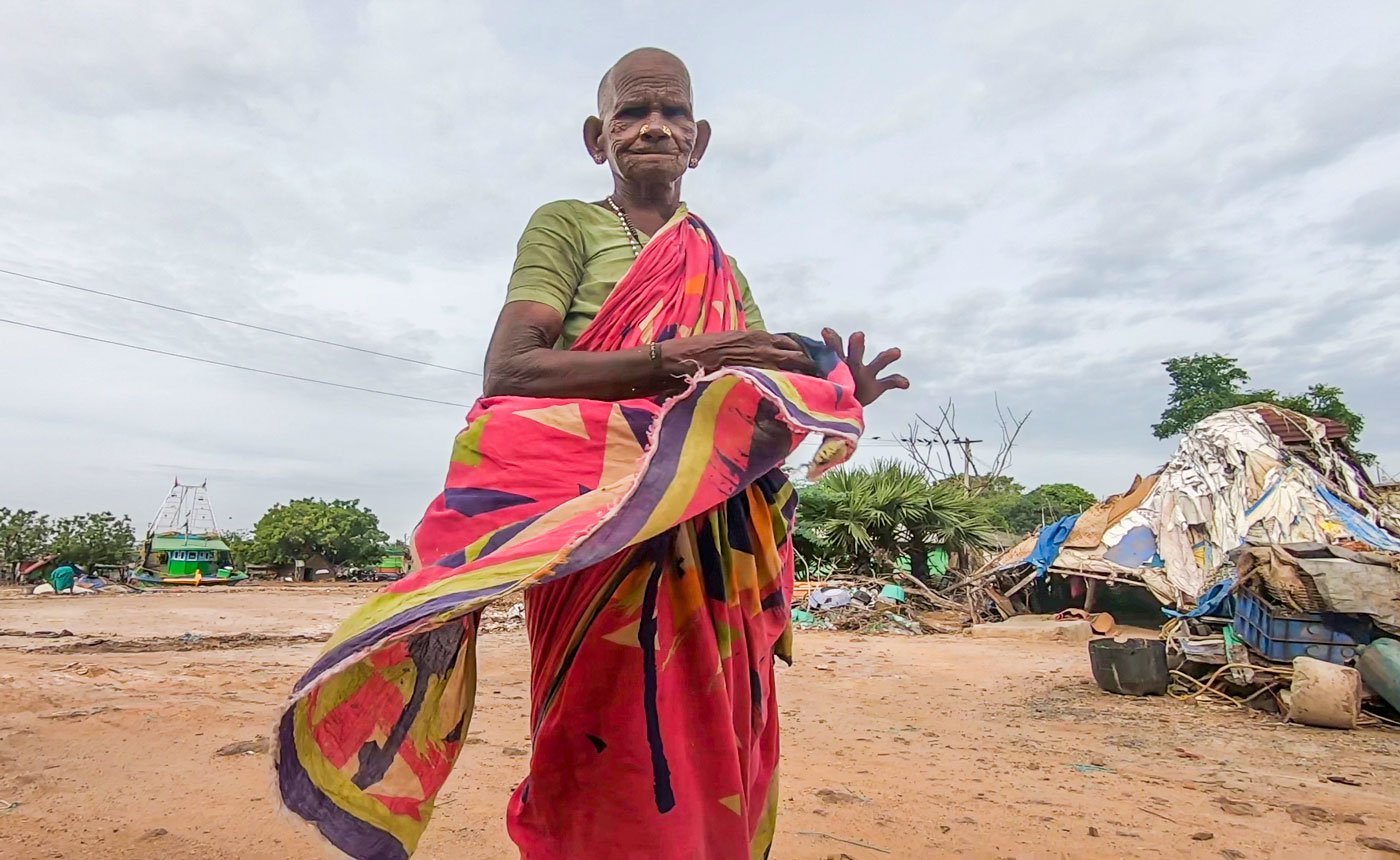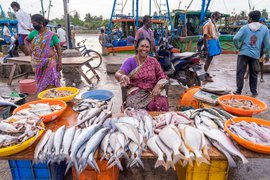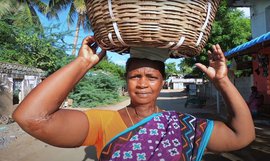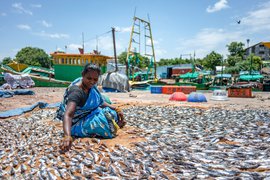उनके दादा ने उनका नाम ‘पुली’ रखा था. तमिल में इसका अर्थ ‘बाघ’ होता है. यह नामकरण श्रम करने की उनकी विलक्षण ऊर्जा के कारण हुआ था - और आज भी के. बानुमति बंदरगाह पर अपने इसी नाम से जानी जाती हैं. वह इस समुद्र तट पर 40 से भी ज़्यादा सालों से काम कर रही हैं और गुज़ारे के लिए मछलियों के बचे-खुचे अवशेषों को इकट्ठा करने, उनकी छंटाई करने और फिर उनको बेचने के काम पर निर्भर हैं. लेकिन तमिलनाडु के कडलूर के मछली बंदरगाह पर काम करने वाली पुली और दूसरी औरतें सरकारी योजनाओं के अधीन श्रमिकों के रूप में स्वीकृत नहीं हैं, और इसीलिए उन्हें किसी प्रकार की सरकार प्रदत्त सामाजिक या आर्थिक सुरक्षा भी हासिल नहीं है.
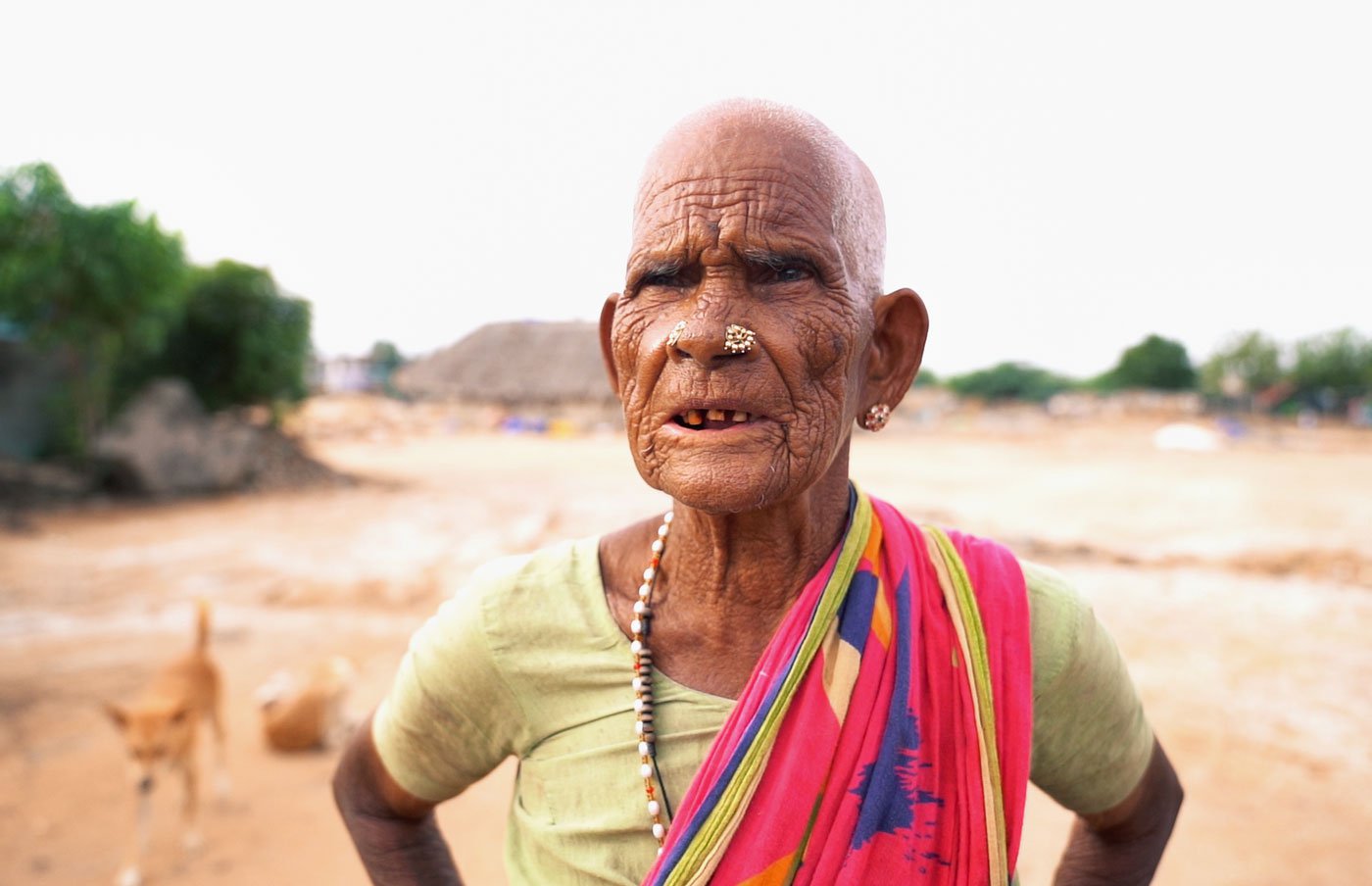
अब लगभग 75 साल की हो चुकी पुली बताती हैं, “मैं जब यहां आई थी, तब मेरी उम्र तक़रीबन 35 साल की रही होगी. फिर मैंने मछलियों की नीलामी का काम शुरू कर दिया." शहर के पूरब में बसे कडलूर ओल्ड टाउन बंदरगाह पर, नीलामी करने वाले कामगार मछलियों की नावों के तट पर पहुंचने पर व्यापारियों की तरफ़ से बोली लगाने का काम करते हैं. कुल बिक्री का 10 प्रतिशत उनको कमीशन के रूप में प्राप्त होता है, बशर्ते उन्होंने नाव में अपनी भी पूंजी लगाई हो. लगभग 20 साल पहले तक यह कमीशन पांच प्रतिशत था. जब पुली सालों पहले इस बंदरगाह पर आई थीं, तब उनके रिश्तेदारों ने इस काम से उनका परिचय कराया था, और दो नावों में पूंजी लगाने के लिए उन्हें 50,000 रुपयों का क़र्ज़ भी दिया था. बाद में इस क़र्ज़ को उन्होंने रोज़ाना घंटों मेहनत करके चुका दिया. उम्र बढ़ने के बाद पुली ने नीलामी का काम बंद कर दिया और इस धंधे को अपनी बेटी को सौंप दिया.
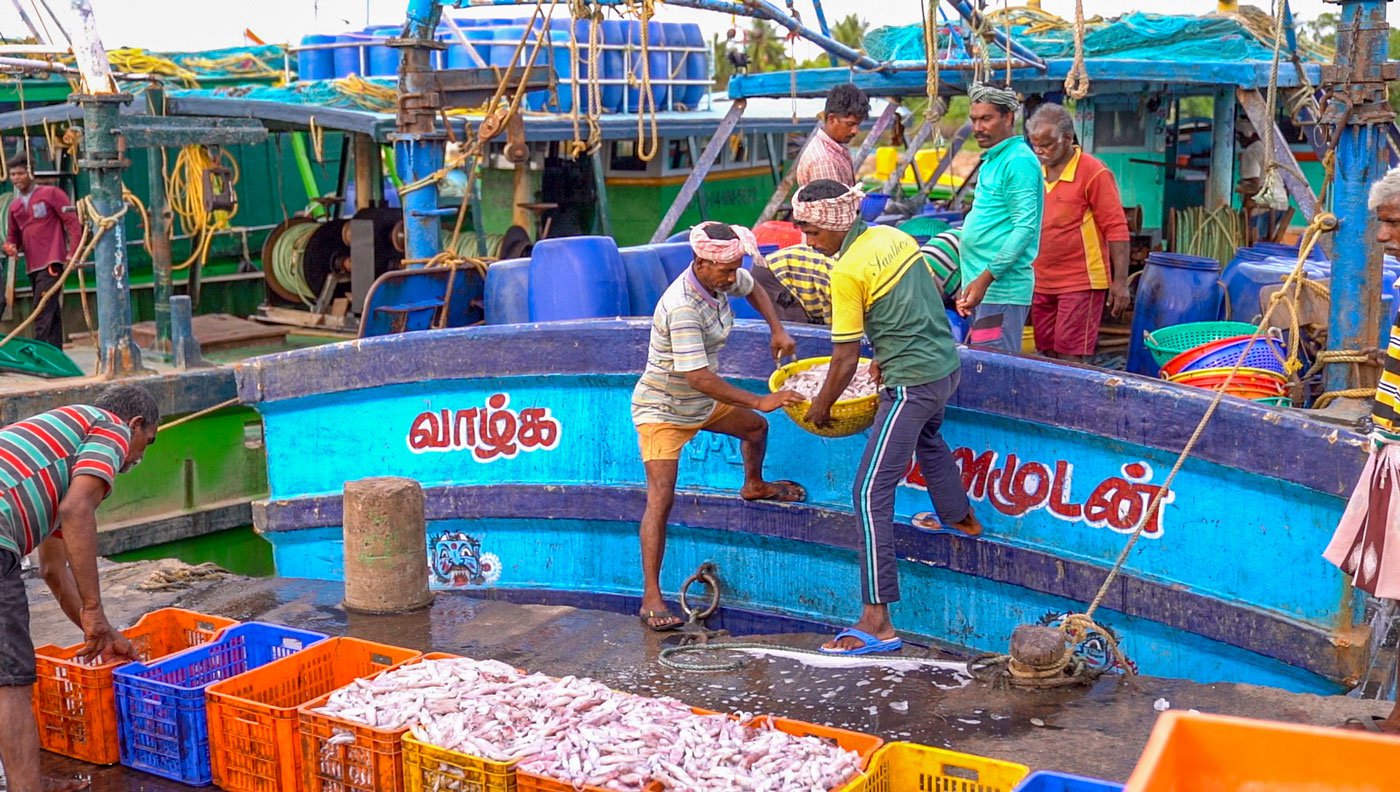
बंदरगाह की गहमागहमी में कई आवाज़ें एक साथ सुनी जा सकती हैं - बोली लगाने के लिए ललकारते कमीशनखोर, मछलियों को उलट-पुलट कर देखते व्यापारी, पकड़ी गईं मछलियों के ढेरों को एक जगह से दूसरी जगह पर पहुंचाते कुली, बर्फ़ को छोटे टुकड़ों में तोड़ती मशीनें, आती-जाती लॉरियां, और मोल-भाव करते खुदरा व्यापारी वगैरह. यह कडलूर ज़िले का एक बड़ा मत्स्य बंदरगाह है, जिसका इस्तेमाल पुली के गांव सोतिकुप्पम के साथ-साथ, पड़ोस के चार और मछुआरों के गांव भी करते हैं. दस साल पहले सेन्ट्रल मरीन फिशरीज रिसर्च इंस्टिट्यूट में दर्ज आंकड़ों के मुताबिक़ इन पांच गांवों में कुल 256 यांत्रिक और मोटर से चलने वाली 822 नावें हैं. हालिया आंकड़े उपलब्ध नहीं हैं.
![“I’d started my kazhar business at the same time [as when I began working at the harbour],” Puli says, referring to her work of collecting and selling fish waste (the scales, heads, tails of fish, shrimp shells and other parts) and bycatch (such as seashells, shrimp, squid and small fishes). This is called kazhivu meen in Tamil, and, more informally, as kazhar. Puli is one of around 10 women at this harbour who collect fish waste and sell it to poultry feed manufacturers – it's a big industry in neighbouring districts like Namakkal. From Rs. 7 for one kilo of kazhar when she started out, the rate now, Puli says, is Rs. 30 per kilo for fish, Rs. 23 for fish heads and Rs. 12 for crab kazhar.](/media/images/04-Puli-3-NR-Puli_gets_by_on_shells_scales.max-1400x1120.jpg)
शल्क, माथे और पूंछ, और मछलियों के दूसरे अवशेषों को इकट्ठा करने और बेचने के अपने काम का हवाला देती हुई पुली कहती हैं, “मैंने कलार बेचने का काम भी तब से ही शुरू किया था, जबसे मैं बंदरगाह पर काम करने आई थी." इन अवशेषों में सीपियां, घोंघे, स्क्विड, और छोटी मछलियां शामिल होती हैं. इन अवशेषों को तमिल में कलिवु मीन और आम बोलचाल की भाषा में कलार कहते हैं. पुली, बंदरगाह में मछलियों के अवशेषों को बीनने और उन्हें मुर्गियों के लिए खाद्य-पदार्थ बनाने वालों को बेचने का काम करने वाली दस औरतों में एक हैं. मुर्गियों के खाद्य-पदार्थ का निर्माण, पास के नामक्कल जैसे ज़िलों में एक बड़ा उद्योग है. जब उन्होंने काम शुरू किया था, तो कलार 7 रुपए प्रति किलोग्राम के भाव से बिकता था. अब पुली के कहे अनुसार यह भाव मछलियों के लिए 30 रुपए प्रति किलो, उसके माथे के लिए 23 रुपए प्रति किलो, और केकड़े के कलार के लिए 12 रुपए प्रति किलो हो गया है.
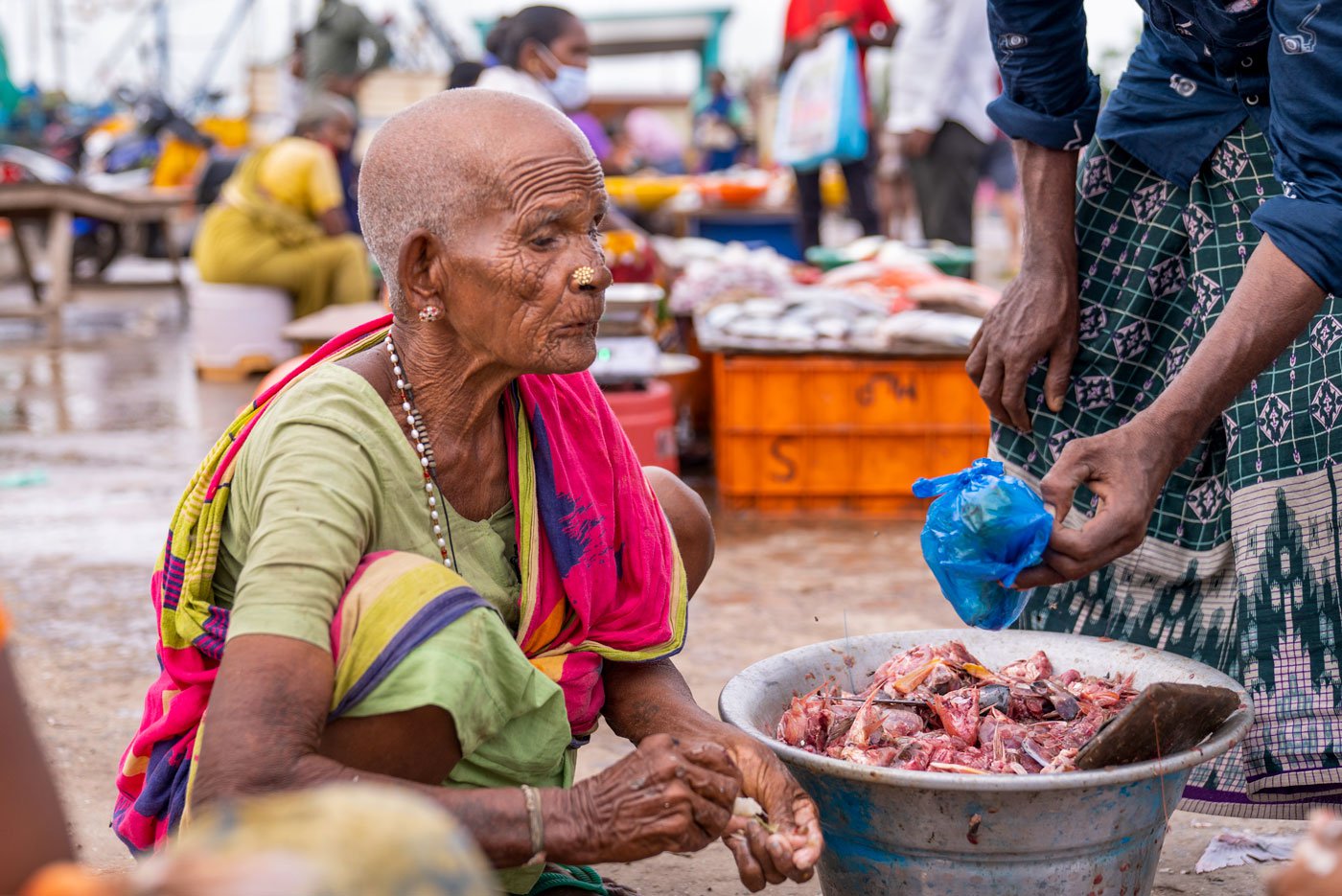
पुली जब 16 साल की थीं, तब उन्हें नागपट्टिनम के एक मछुआरे से ब्याह दिया गया था. दोनों के चार बच्चे भी हुए, लेकिन उनका पति कुप्पुसामी उन्हें मारता-पीटता था. इसलिए, उनके पिता, जोकि सोतिकुप्पम में पंचायत स्तर के एक नेता थे, ने उन्हें बच्चों को लेकर घर लौट आने के लिए कहा. इसके तीन साल बाद ही पुली की मां चल बसी. वह भी जीविका के लिए मछलियों की नीलामी का काम करती थीं. पुली बताती हैं, “उसके बाद मेरे रिश्तेदारों ने मुझे यह काम शुरू करने के लिए कहा. बच्चों को बड़ा करने के लिए मुझे भी पैसों की ज़रूरत थी.”
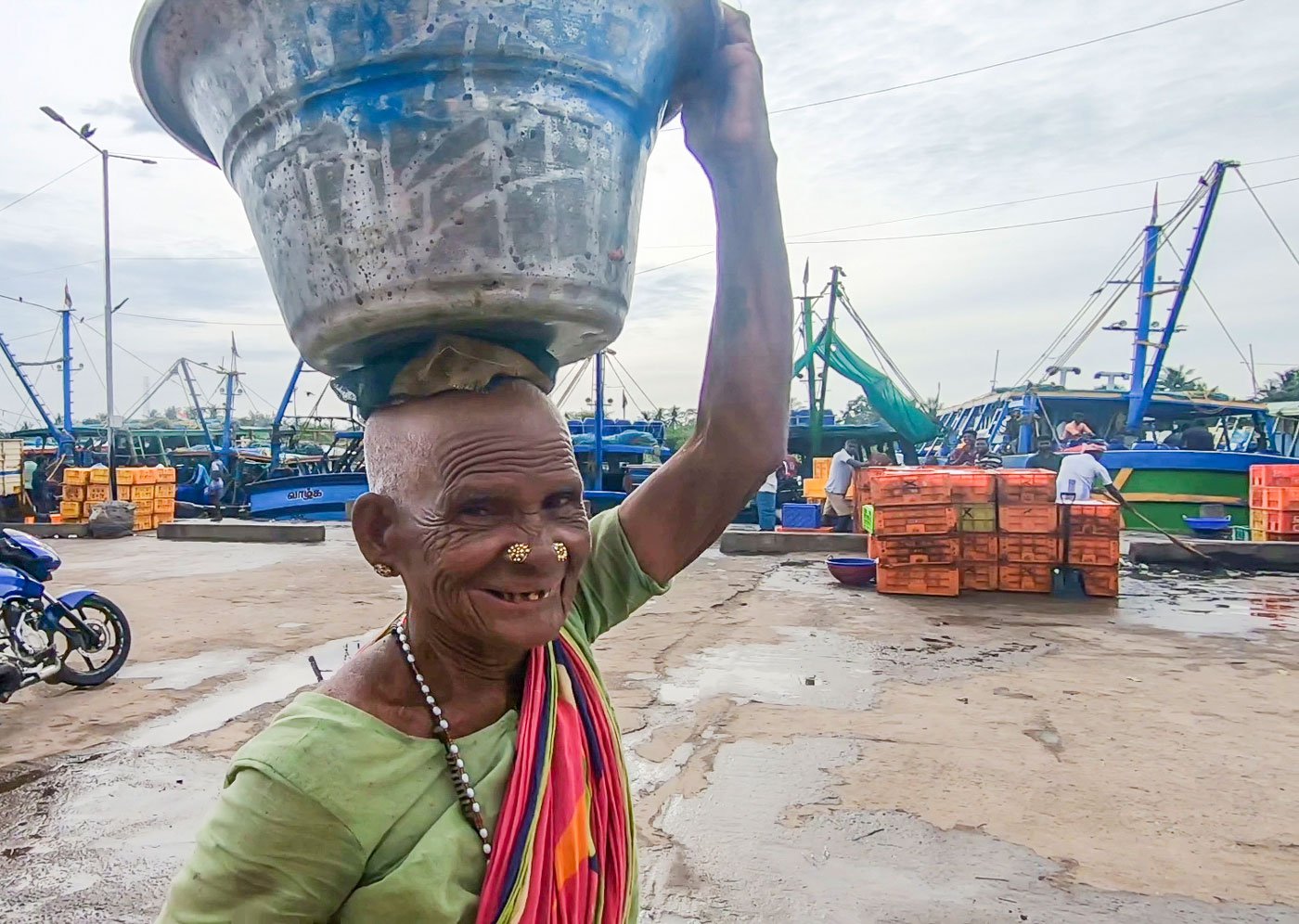
वह बंदरगाह पर सुबह 4 बजे से लेकर शाम 6 बजे तक रहती हैं - और अवशेषों में नमक मिलाने से लेकर उसकी पैकिंग और बिक्री के कामों में जुटी रहती हैं. पहले दिन कलार में नमक मिलाया जाता है, ताकि उसकी बास को कम किया जा सके. दूसरे दिन उसे सुखाकर मेश बैग (जालीदार बैग) में उसकी पैकिंग की जाती है, जिन्हें वह बंदरगाह पर ही 4 रुपए प्रति पीस की दर से ख़रीदती हैं. वह जूट की बनी, नमक की बोरियों का भी दोबारा इस्तेमाल करती हैं, जिन्हें वह 15 रुपए प्रति पीस की दर से ख़रीदती हैं.
पुली बताती हैं कि कलार से भरी एक बोरी का वज़न 25 किलोग्राम होता है. पहले वह हफ़्ते में 4-5 बोरियां बेच लेती थी, लेकिन कोविड-19 महामारी और रिंग सेन जालियों (मछलियां पकड़ने का जाल) पर प्रतिबंध लगाए जाने के बाद से मछलियां अब कम पकड़ी जा रही हैं, और पुली के धंधे में भी बहुत गिरावट आ गई है. अब वह बमुश्किल नामक्कल के ख़रीदारों को हफ़्ते में दो बोरियां ही बेच पाती हैं, जिससे हर हफ़्ते उन्हें क़रीब 1,250 रुपयों की कमाई ही हो पाती है.
कडलूर बंदरगाह पर औरतें बोली लगाने से लेकर बोझ उठाने, मछलियों को सुखाने, और कलार छांटने जैसे सभी काम करती हैं, लेकिन अपनी रोज़ की कमाई की अनिश्चितता के बारे में बताती हैं. मछुआरों के इन गांवों की अधिकतर युवा औरतें ख़ुद को मछली पकड़ने के काम से दूर रखना चाहती हैं. नतीजतन, बंदरगाह पर काम करने वाली ज़्यादातर औरतें बुज़ुर्ग ही दिखती हैं.
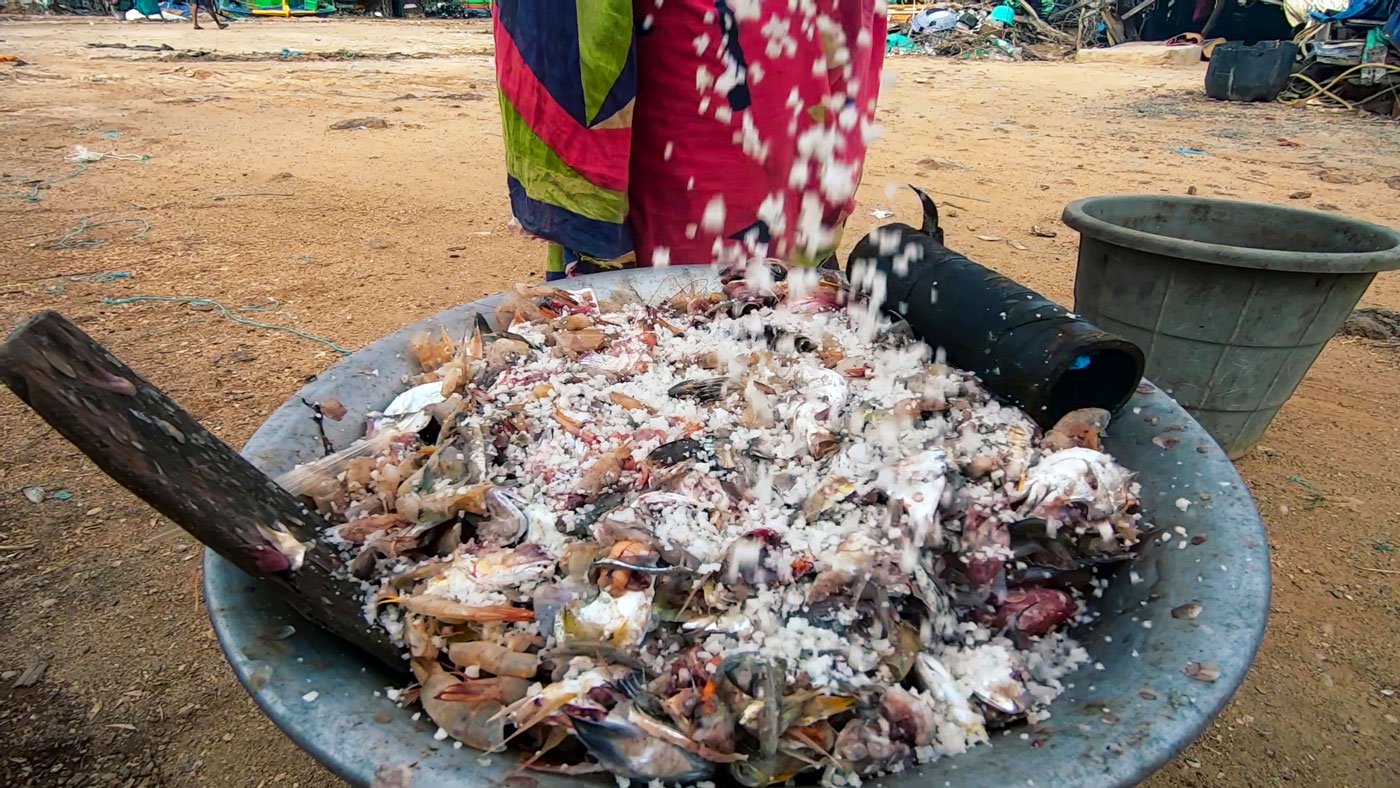
पुली कहती हैं, “कलार के एवज में मुझे एक भी पैसा नहीं देना होता है. मैं इसे बंदरगाह पर मछली काटने वाली औरतों से इकट्ठा करती हूं.” रोज़ सुबह चार बजे से वह मछलियों के खुदरा विक्रेताओं और ग्राहकों की ज़रूरत के मुताबिक़, उसके शल्क और आंतें निकालने वाले दूसरे लोगों से अवशेषों को इकट्ठा करने के काम में लग जाती है. चूंकि पुली कलार के लिए पैसे नहीं देती हैं, इसलिए कभी-कभार वह मछली बेचने और काटने वालों को कोल्ड ड्रिंक ख़रीद कर पिलाती हैं. वह कहती हैं, “मैं उनकी जगह की सफ़ाई करने में भी मदद कर देती हूं. मैं उनके साथ बातें करती हूं और इधर-उधर की गपशप भी साझा करती हूं.”
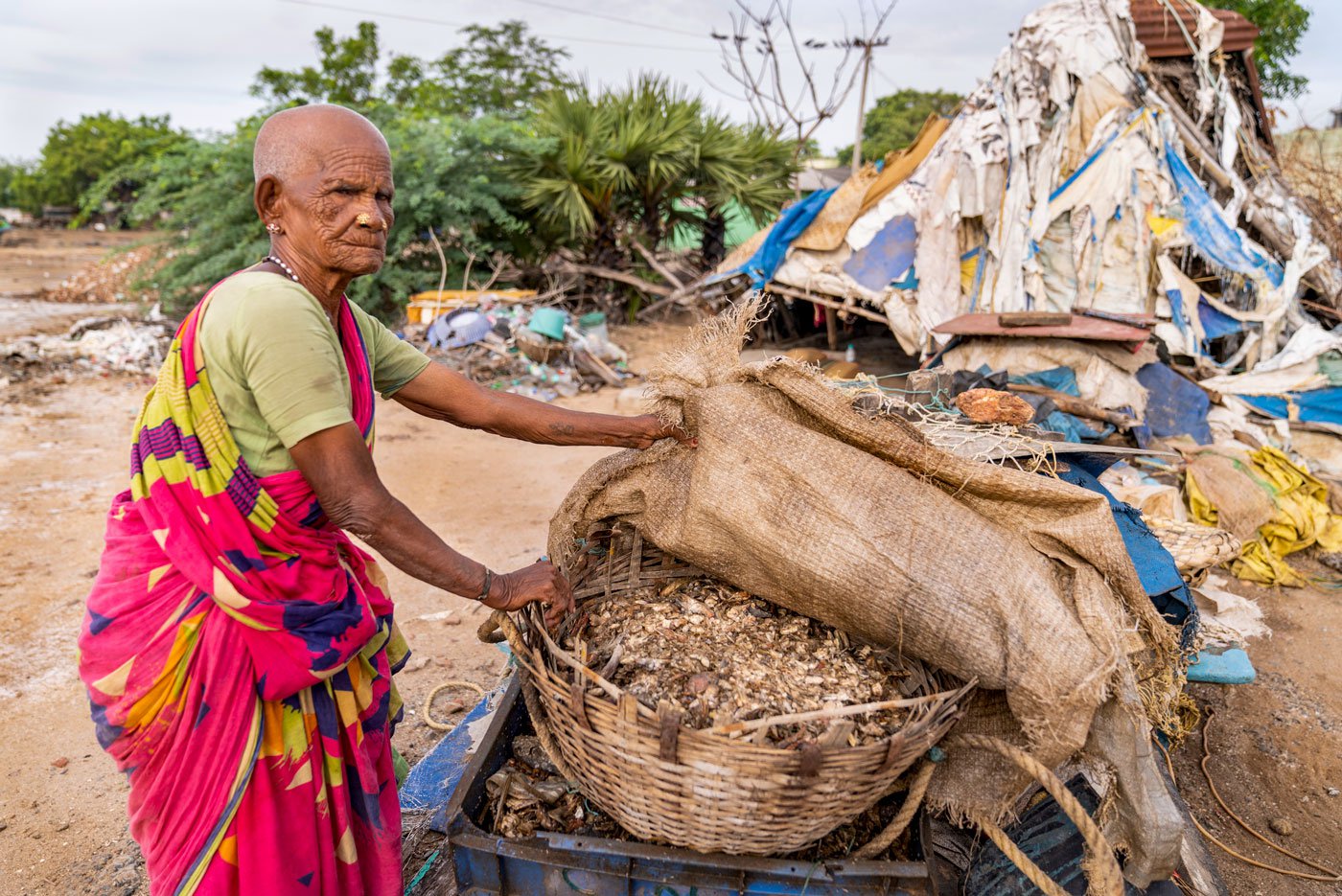
कडलूर बंदरगाह पर काम करने वाली औरतें सीधे-सीधे मछलियों के व्यापार और प्रसंस्करण के साथ-साथ, परोक्ष रूप से इस व्यवसाय और व्यवसायियों के लिए ज़रूरी बर्फ़ के टुकड़े, पीने के लिए चाय, और मज़दूरों की भूख मिटाने के लिए पकी हुई खाद्य सामग्रियां बेचने जैसे कामों में भी लगी हैं. राष्ट्रीय मत्स्य पालन नीति 2020 के अनुसार मत्स्य पालन उद्योग में प्रयुक्त श्रम में 69 प्रतिशत भागेदारी केवल महिलाओं की है. अगर परोक्ष व्यापार को भी इसमें शामिल कर लिया जाए, तो मछली पालन मुख्यतः महिला-श्रम पर निर्भर रहने वाला उद्योग है.
साल 2020 की यह नीति, मत्स्यपालन के क्षेत्र में औरतों की भागीदारी को बढ़ाने के उद्देश्य से सहकारिता तथा उनके लिए काम के वातावरण और शर्तों को अनुकूल बनाने की योजनाओं और आवश्यकताओं को स्वीकार करती है. बहरहाल, दुर्भाग्य से ये समस्त योजनाएं औरतों के रोज़मर्रा की मुश्किलों से निपटने के बजाय मत्स्यपालन उद्योग के यांत्रिकीकरण पर अधिक केन्द्रित हैं.
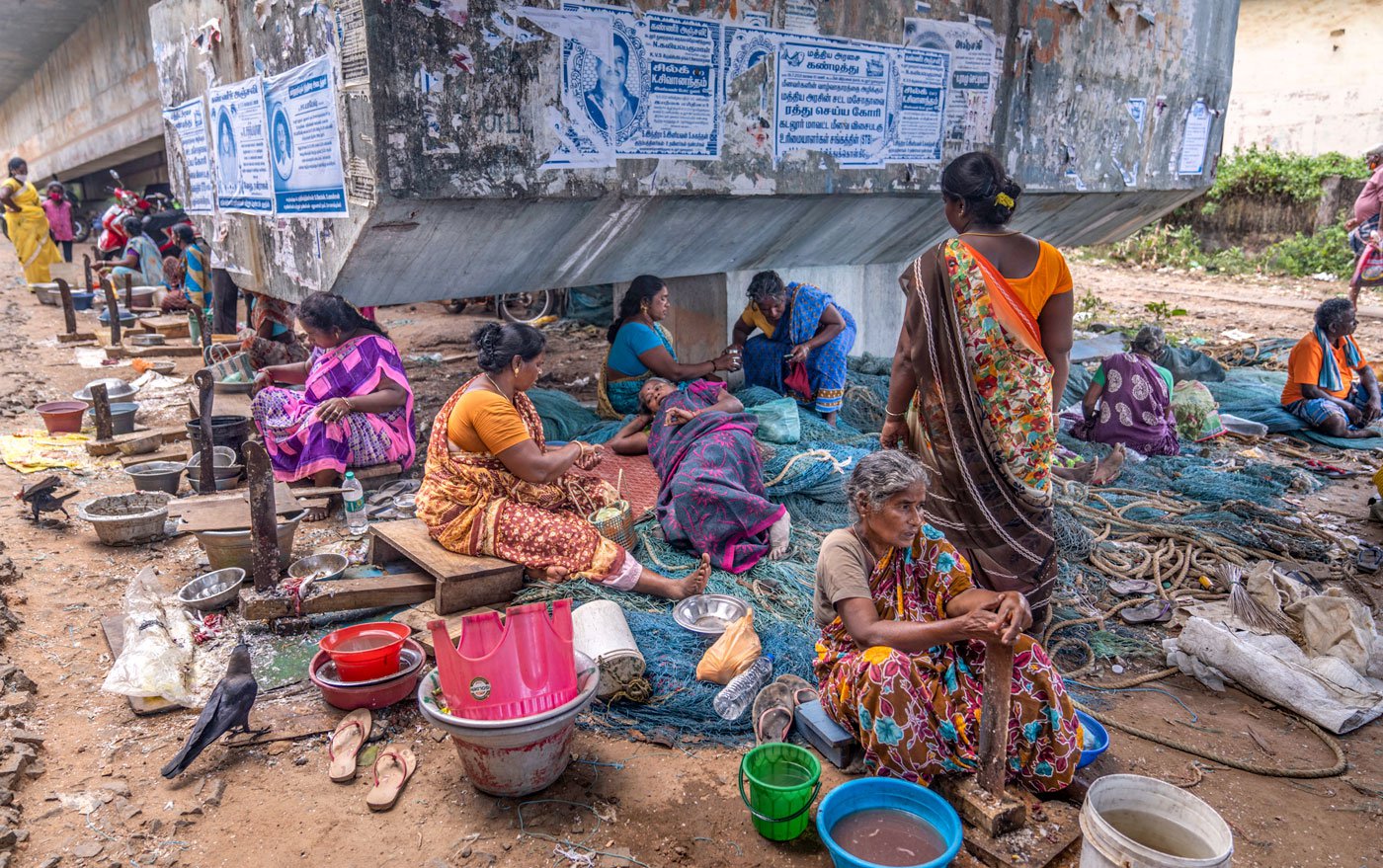
मछलियों के कारोबार में कार्यरत औरतों की मदद और उनकी भूमिका को प्रोत्साहित करने के क़दम उठाने के बजाय तटीय परिवर्तनों, पूंजी निवेश, और निर्यात-केन्द्रित नीति के आधार पर उन्हें इस कारोबार में सहभागिता से और इससे होने वाले लाभ से वंचित किया जा रहा है. ज़ाहिर है कि ये परिवर्तन और नीतियां, इस क्षेत्र में औरतों के योगदान को नज़रअंदाज़ करती हैं. औरतों को इस उद्योग में आने देने में एक बड़ी बाधा सूक्ष्म आधारभूत संरचनाओं में बढ़ता हुआ निवेश और 1972 में स्थापित हुई मरीन प्रोडक्ट एक्सपोर्ट डेवलपमेंट अथॉरिटी है, जिसने निर्यात को बढ़ाया और लघु-स्तरीय मत्स्यपालन को हतोत्साहित करने का काम किया. साल 2004 में सुनामी आने के बाद यह प्रक्रिया और तेज़ हो गई, क्योंकि नई नावों और उपकरणों में अधिक निवेश किया जाने लगा है.
समय गुज़रने के साथ, ज़्यादा से ज़्यादा तादात में औरतें इस कारोबार से बाहर होती जा रही हैं, बल्कि बाहर की जा रही हैं. कडलूर बंदरगाह की औरतों की यह आम शिकायत है कि वे मछली बेचने, काटने, सुखाने, और बंदरगाह की साफ़-सफाई के काम से दिन-ब-दिन बेदख़ल की जा रही हैं. कुछ ही औरतें मछली बेचने के कामों में अभी भी लगी हैं और जिन्हें सरकारी एजेंसियों की तरफ़ से आइसबॉक्स उपलब्ध कराया गया है. अब कुछ ही गांव और शहरों के बाज़ारों में ख़ास उनके लिए आवंटित जगहें बची हैं, जिसके चलते उन्हें मछली बेचने के लिए मीलों दूर की जगह तक पैदल चलकर जाना पड़ता है.
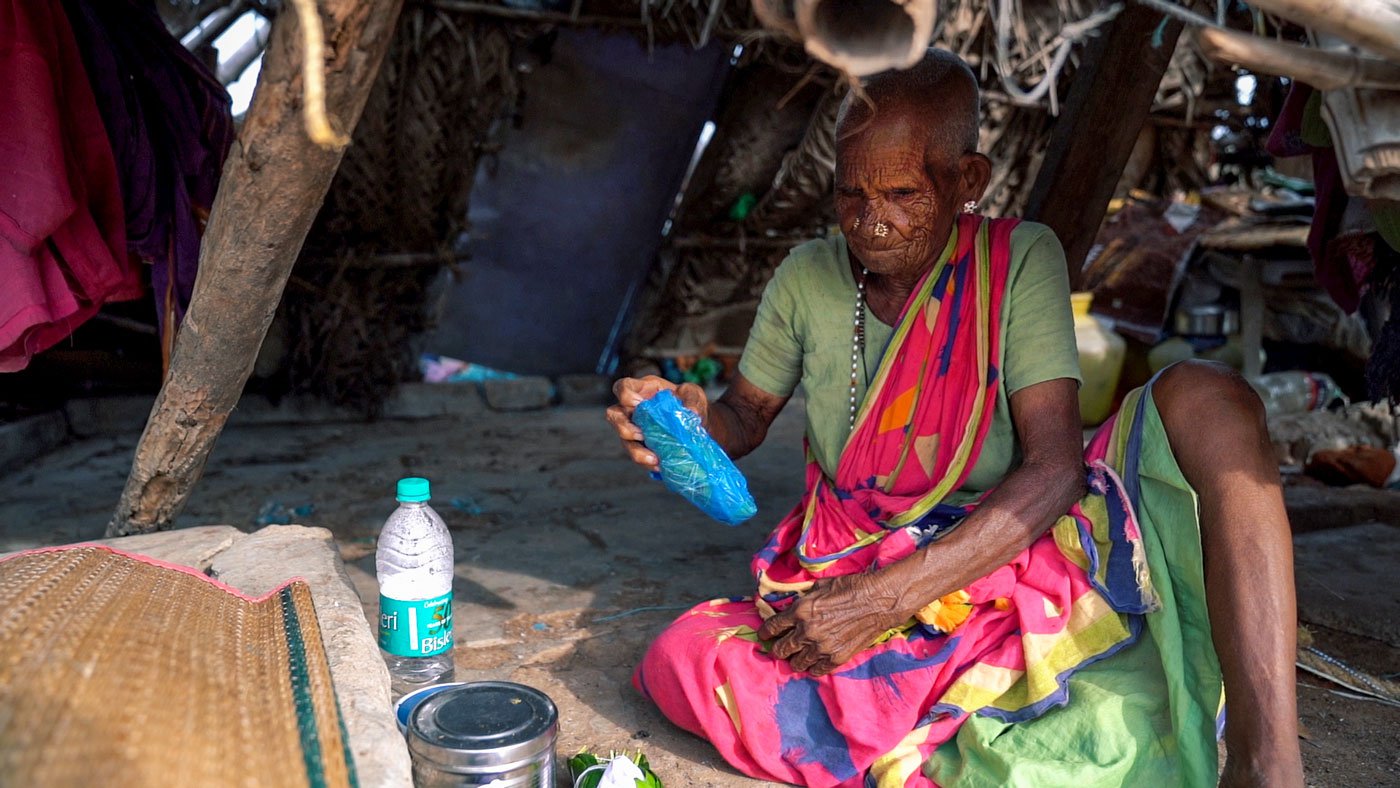
पुली कहती हैं, “मैं यहां बंदरगाह के क़रीब ही एक छोटी सी झोपड़ी में रहती हूं, ताकि मैं अपने काम की जगह से अधिक नज़दीक रहूं." लेकिन जब बारिश होती है, तब वह अपने बेटे मुत्तु के घर पर रहने लगभग तीन किलोमीटर दूर सोतिकुप्पम चली जाती हैं. मुत्तु (58 साल), जो ख़ुद भी बंदरगाह के मछुआरे हैं, रोज़ पुली को खाना पहुंचाते हैं. पुली को प्रत्येक महीने 1,000 रुपए की वृद्धावस्था पेंशन भी मिलती है. पुली मछली के काम से होने वाली अपनी ज़्यादातर कमाई अपने बच्चों – दो बेटे और दो बेटियों - को दे देती हैं. वे सभी 40 और 60 के बीच की उम्र के हैं और कडलूर ज़िले में मत्स्य पालन से जुड़े काम करते हैं. पुली जैसे ख़ुद से पूछती हैं, और ख़ुद उसका उत्तर भी देती हैं, “मुझे अपने साथ क्या ले जाना है? कुछ नही."
यू. दिव्यउतिरण के सहयोग से.
अनुवाद: प्रभात मिलिंद
